The Rosewill Photon 1050W Review
by E. Fylladitakis on March 24, 2015 8:00 AM EST- Posted in
- Cases/Cooling/PSUs
- Rosewill
- 1050W
- Sirfa
Hot Test Results
By the results presented in the following tables, the Rosewill Photon 1050W offers good power quality, especially considering the temperatures that the components reached inside our hotbox. The maximum ripple on the 12V line was 56mV under full load, a fair figure considering that this is a unit rated for operation at 40°C. The 3.3V/5V voltage lines fared better, with the maximum ripple being 22mV/24mV respectively. Voltage regulation is very good, at just 1.2% for the 12V line and about 1.6% for the minor lines.
| Main Output | ||||||||
| Load (Watts) | 212.08 W | 528.3 W | 788.6 W | 1047.54 W | ||||
| Load (Percent) | 20.2% | 50.31% | 75.1% | 99.77% | ||||
| Line | Amperes | Volts | Amperes | Volts | Amperes | Volts | Amperes | Volts |
| 3.3 V | 4.17 | 3.37 | 10.44 | 3.35 | 15.66 | 3.33 | 20.87 | 3.31 |
| 5 V | 4.17 | 5.13 | 10.44 | 5.09 | 15.66 | 5.07 | 20.87 | 5.05 |
| 12 V | 14.61 | 12.09 | 36.53 | 12.05 | 54.8 | 11.99 | 73.06 | 11.95 |
| Line | Regulation (20% to 100% load) |
Voltage Ripple (mV) | |||||
| 20% Load | 50% Load | 75% Load | 100% Load | CL1 12V |
CL2 3.3V + 5V |
||
| 3.3V | 1.6% | 8 | 12 | 18 | 22 | 12 | 26 |
| 5V | 1.55% | 10 | 16 | 22 | 24 | 16 | 26 |
| 12V | 1.2% | 20 | 32 | 44 | 56 | 54 | 20 |
Once again, we need to mention that this is a PSU rated at 40°C and we perform our testing at temperatures higher than 45°C - we could reduce the ambient temperature of our hotbox testing but we chose not to do so as the results would then not be comparable to those of our previous reviews.
The high ambient temperatures have a significant impact on the electrical performance of the Photon 1050W, reducing its energy conversion efficiency by an average of 2%. The drop is higher as the load increases, reaching a massive 3.7% drop with a load of 1050W. Considering that the ambient temperature is almost 48°C at this point, these actually are overload conditions for the Photon, meaning that its capability to maintain good power quality and keep operating with such a load is a victory all by itself.
By looking at the internal temperatures of the Photon 1050W, one can easily realize who the culprit behind the dropping efficiency is. This is one of the hottest PSUs we have ever tested. With the temperature of the secondary side heatsink surpassing 100°C under maximum load and the primary side heatsink following closely, it is easy for anyone with basic electronics knowledge to deduct that the exceedingly high temperatures at the very least increase the resistance of the components. The cooling fan is now audible even at low loads, with its speed constantly increasing to keep up with the increasing energy losses. Even though it jumps at maximum speed when the load is about 900 Watts, it cannot stay ahead of the curve with the heavy energy losses.


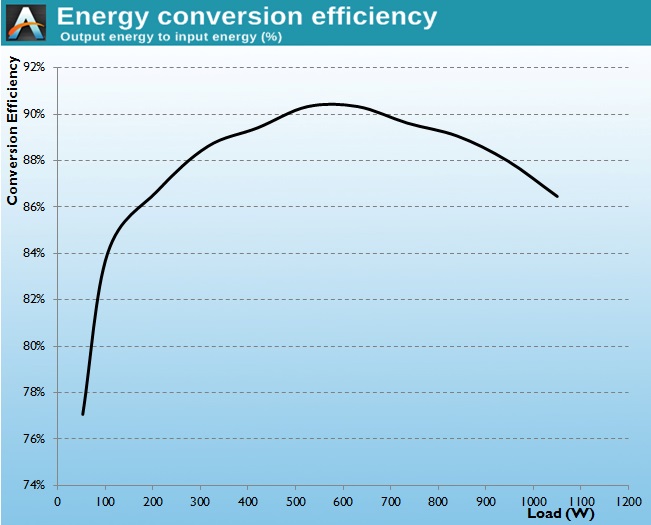
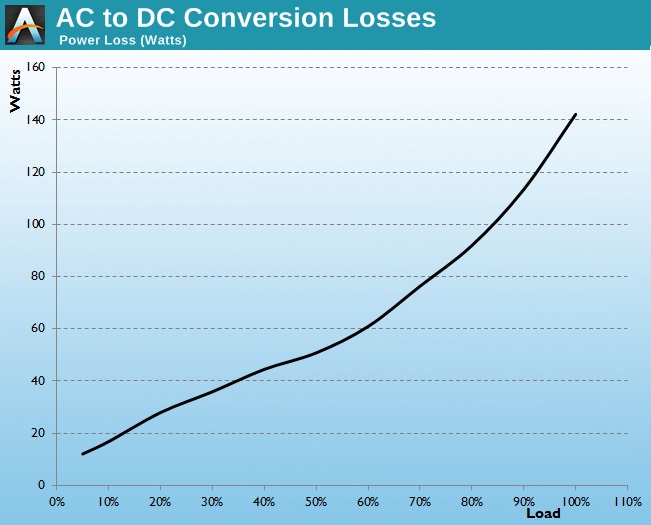
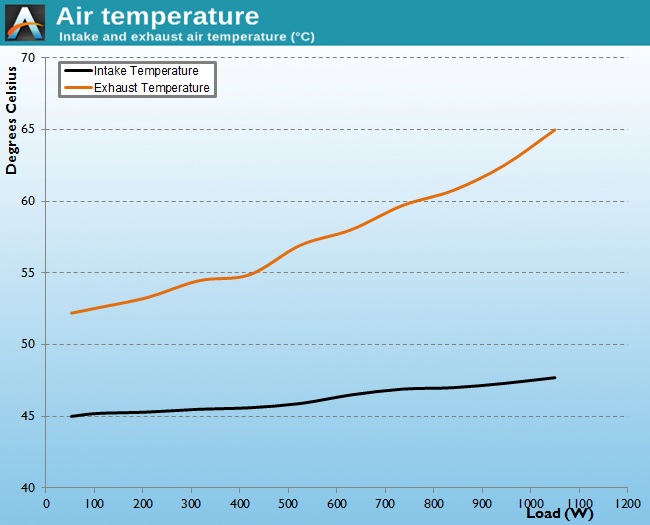
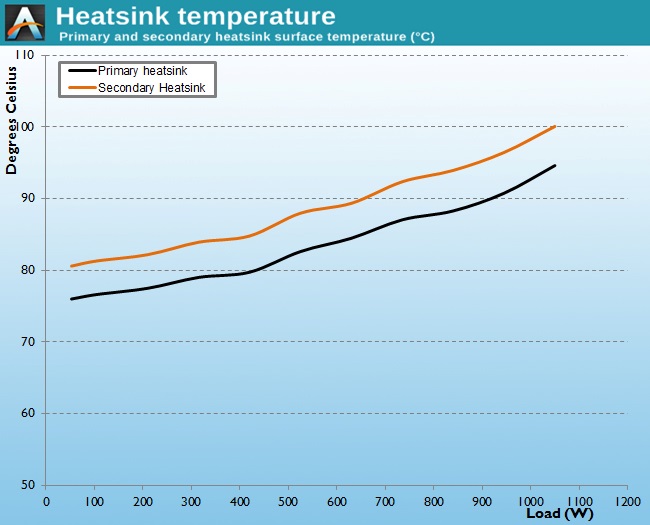
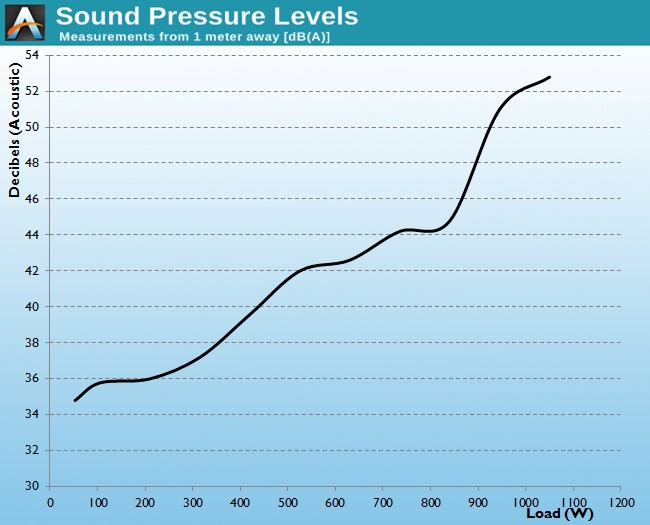








42 Comments
View All Comments
DanNeely - Tuesday, March 24, 2015 - link
Am I correct in thinking that this PSU, and other recent models capable of producing their entire output rating at 12V (give or take rounding on the amperage) are pure 12V designs internally that then use DC-DC converters to make the 3.3/5V rails instead of the traditional design that had separate circuitry for the 3.3/5v and 12v rail. With the older design having problems in cross load tests (when one side was maxed and the other only had a minimum load), the change in design seems a reasonable way to handle the shift of almost everything on the mobo to 12V operation; but I haven't seen it confirmed anywhere.MrCommunistGen - Tuesday, March 24, 2015 - link
Yes, many modern power supplies are built on a platform that only does AC to 12V DC, then use DC to DC conversion to get the 5V and 3.3V rails. I can think of all kinds of reasons that might provide cleaner power or be more efficient, but I'll leave that discussion to the experts.DanNeely - Tuesday, March 24, 2015 - link
Is the -12V (used for RS232) done that way too, or does it still get a special side circuit like the 5V standby.Gigaplex - Tuesday, March 24, 2015 - link
Why are the PSU reviews disproportionately focusing on 1kW and higher units? Even a high end SLI/Crossfire rig will struggle to load these PSUs. Especially with Intel and NVIDIAs latest power efficient architecture. How about some more reviews on units likely to be utilised by us mere mortals not doing quad Titan SLI?chlamchowder - Tuesday, March 24, 2015 - link
I agree. It's cool to read about ridiculously high end units. But few people are using dual graphics cards, and even fewer are going with more. I'd love to see reviews on lower priced units.For example, I recently built a computer with <400W power requirements. So, I got a $40 EVGA 500W supply - the cheapest 80+ supply I could find. There were approximately zero reviews of that unit on review sites (but plenty of user reviews on Newegg, for what that's worth).
For anyone who's wondering, that supply (100-W1-0500-KR R) is nice and quiet, even when feeding an overclocked FX-8350.
TomWomack - Tuesday, March 24, 2015 - link
I agree entirely; a review of PSUs starting from the absolutely cheapest, determining which ones work adequately, would be really useful. An i7/4790K with 16G memory and an SSD is a 150W system; to learn, with the kind of confidence that one of Anandtech's comprehensive reviews provide, that a $20 PSU from newegg is adequate would be quite helpful.jabber - Tuesday, March 24, 2015 - link
Hear hear! The number of people who look at this site that really really need such a PSU is probably less than 5%. Please lets have more reviews in the 450-750W range.jabber - Tuesday, March 24, 2015 - link
Oh and some nice reviews of specialist 200-400W would be good too.FunBunny2 - Saturday, March 28, 2015 - link
Yeah, but... AT's New Overseers clearly are going down the Apple Road: cater to the 20% rich and dumb enough to drop large coin on useless bling.gsuburban - Sunday, June 28, 2015 - link
Agreed. I don't use graphics cards any longer for computing, Intel HD Graphics will do. Thus, a PSU's total wattage isn't a main focus while the quality of it is. 650 watts is our limit in the long run for a non-discrete graphics machine and 750 to 850 with one.